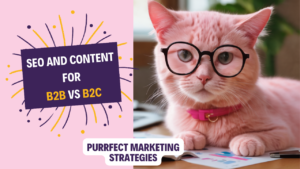In the ever-evolving landscape of digital marketing, it’s crucial to recognise that the approach to SEO (Search Engine Optimisation) and content strategies can vary significantly between B2B (Business-to-Business) and B2C (Business-to-Consumer) selling propositions.
Understanding the characteristics and needs of these two markets is the key to a successful online presence. In this article, I’ll explore how to tailor your SEO and content strategies to effectively target B2B and B2C audiences.
Drawing from my extensive experience in the field of marketing, I’ve had the privilege of working with a diverse array of B2B and B2C companies: from online shops to multinational language service providers, engaging in the promotion of both products and services, my human friends. Yes, some companies have no objections to having a pink cat doing their marketing!
It’s become increasingly apparent that the intricacies of creating effective content and SEO strategies for these two distinct markets couldn’t be more different. Surprisingly, the amount of available information on this topic remains rather limited, leaving a noticeable gap that I’m eager to fill.
This article is the result of my desire to share insights and practical guidance based on real-world experience, aimed at shedding light on the unique challenges and opportunities that marketers encounter when navigating the B2B and B2C landscapes.
In the article Differences between SEO for transactional (eCommerce or services) vs informational sites I digged deep into how to approach SEO depending on the purpose of your site. It is worth a reading once you have your B2B/B2C content strategy clear.
How to do SEO and Content for B2B vs B2C: Different Audiences, Approaches
Before delving into the specifics, let’s first understand the fundamental differences between B2B and B2C audiences:
B2B (Business-to-Business):
– B2B customers are often other businesses or professionals.
– The purchasing process is typically longer and involves multiple decision-makers, for example, the finance or purchase team, any relevant line managers, etc.
– Buyers prioritise rational factors such as ROI, efficiency, and reliability.
– Content must demonstrate expertise and help solve complex business problems.
– Building trust and credibility is crucial in B2B relationships.
B2C (Business-to-Consumer):
– B2C customers are individual consumers.
– The purchasing process is shorter, often influenced by emotions and impulse.
– Buyers seek personal benefits, enjoyment, and convenience.
– Content aims to captivate and engage consumers on a personal level.
– Brand appeal, visual aesthetics, and emotional connection are essential.
Now that we’ve established the fundamental differences, let’s explore how to approach SEO and content strategies for each:
B2B SEO and Content Strategies:
When it comes to creating content that is SEO-focused for business clients, this is what you should take into account:
1. Keyword Research and Targeting:
– Identify keywords relevant to industry-specific terms, professional queries, and business solutions.
– Focus on long-tail keywords that reflect the specific challenges and needs of B2B customers.
2. High-Quality Content:
– Produce in-depth, informative content that showcases expertise and industry knowledge.
– Utilise whitepapers, case studies, and research reports to address complex business issues.
– Emphasise data-driven insights to support your claims.
3. Lead Generation:
– Implement lead magnets like webinars, e-books, and industry reports to capture potential clients’ information.
– Encourage users to subscribe to newsletters or request consultations.
4. Content Personalization:
– Tailor content to different decision-makers within the organisation.
– Address common pain points and offer tailored solutions.
5. Link Building and Networking:
– Collaborate with industry influencers, partners, and other businesses to build backlinks.
– Participate in B2B events, webinars, and conferences to expand your network.
B2C SEO and Content Strategies:
When it comes to creating content that is SEO-focused for individuals, this is what you should look at:
1. Keyword Research and Targeting:
– Identify consumer-oriented keywords related to products, services, and consumer preferences.
– Consider the emotional and personal aspects of buying decisions.
2. Engaging Content:
– Create visually appealing and emotionally resonant content.
– Utilise product videos, user-generated content, and lifestyle imagery to appeal to consumers.
3. E-commerce Optimisation:
– Ensure product descriptions, images, and reviews are optimised for search engines.
– Implement schema markup to enhance product visibility in search results.
4. User Experience (UX):
– Optimise website speed, mobile-friendliness, and navigation for a seamless consumer experience.
– Use A/B testing to refine website elements and conversion paths.
5. Social Media and Influencer Marketing:
– Leverage social platforms for brand promotion and customer engagement.
– Collaborate with social media influencers to reach a broader audience.
Common Content Strategies for Both B2B and B2C:
1. Content Quality and Relevance:
– Regardless of the target audience, content must be well-researched, relevant, and valuable.
– Address the needs and concerns of your customers.
2. Mobile Optimization:
– Mobile-friendliness is vital in both B2B and B2C markets, as mobile device usage continues to rise.
3. Local SEO:
– Optimise for local search to attract nearby customers or businesses.
– Claim and optimise your Google My Business listing.
4. Analytics and Iteration:
– Regularly analyse performance metrics to refine your strategies.
– Adapt to algorithm changes and emerging trends in SEO and content marketing.
In the world of SEO and content marketing, a one-size-fits-all approach doesn’t apply. Tailoring your strategies to the specific needs and behaviours of B2B and B2C audiences is essential. Understanding the distinct characteristics, priorities, and purchasing processes of these two markets will enable you to create compelling content and achieve greater success in your online marketing efforts. Whether you’re targeting businesses or consumers, the right strategy can make all the difference in building brand awareness and driving conversions.
Here are other content related articles that you might find useful:
Does having multiple categories in WordPress affect SEO?
What is programmatic SEO and how to use it to boost your marketing efforts.
How to use Chat GPT to write marketing content and AI prompt examples.
Boost Your Content Marketing Strategy with Content Marketing Templates
How to Create a Content Marketing Strategy
Programmatic SEO with ChatGPT: A Real Case Study that Boosted Rankings
How to Advertise Financing for High-Ticket Products: A Step-by-Step Finance Campaign Strategy
Differences between SEO for transactional (eCommerce or services) vs informational sites
Stay curious and pounce back here for more marketing magic, my purr-fect pals!
Missing me already, dear human? You can find me on X and Facebook.
Moxie

